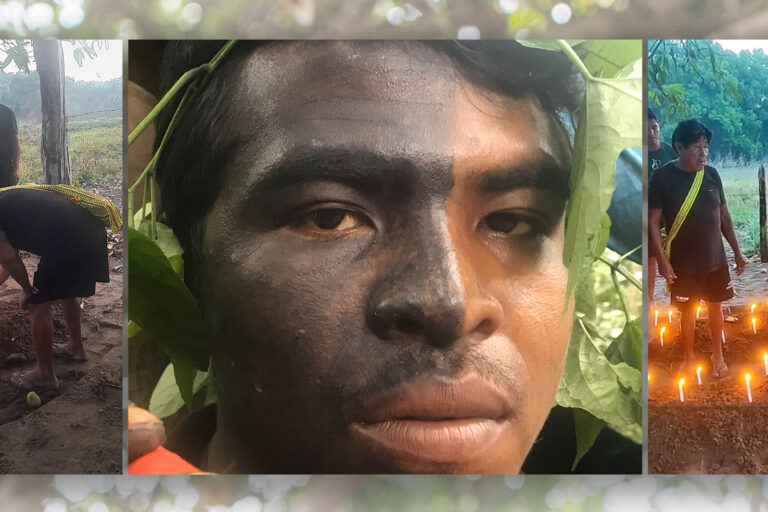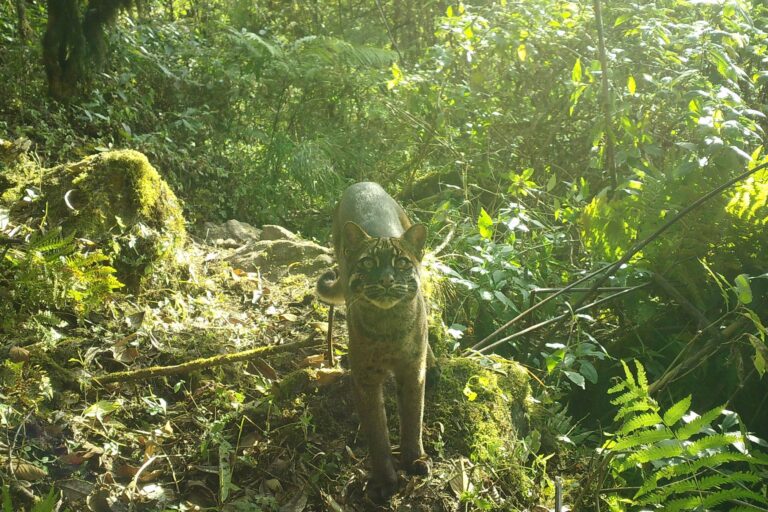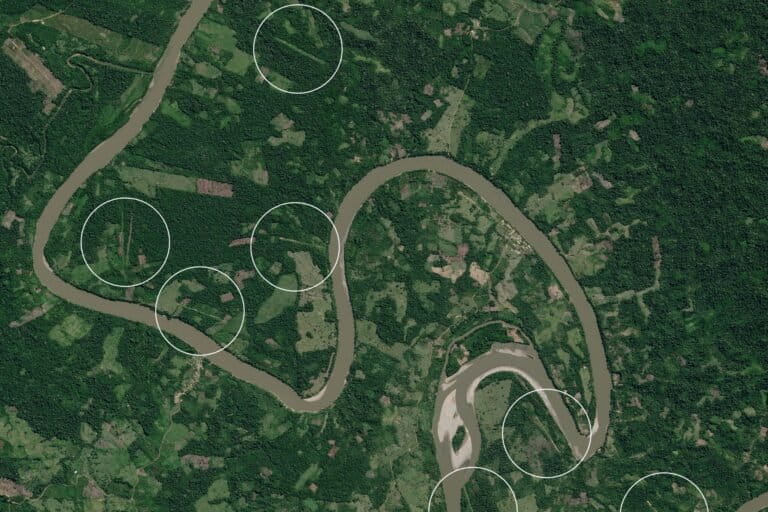
Mali elephant family group which consist of females and their offspring. They are headed by a matriarch who has decades of experience and memories to depend on, including where to find water during droughts. Photo by: Carlton Ward Jr.
At a time when Africa’s elephants are facing a relentless poaching crisis—to the tune of over 20,000 dead every year—one community has managed to safeguard their elephants in the most unlikely of places: Mali. In a country that has suffered from widespread poverty, environmental degradation, and, most recently, warfare, a collaboration between elephant conservationists and a diverse local community has kept Mali’s elephants, which are the most northerly in Africa, from extinction.
Conservationist Susan Canney (see her TEDx Talk below) with the Mali Elephant Project began her work in the country by studying the long, distinct migration undertaken by the country’s hardy, desert-surviving elephants, but ended up working desperately to keep the herds, which number over 500 elephants, alive.
“When we started this work it was clear the area was suffering from resource degradation and over-exploitation,” Canney explained in a recent interview with mongabay.com. “People were clearing bushland to cultivate, only to abandon it after a couple of years leaving the soil to erode. Increasingly large herds of cattle were drinking the lakes dry and trampling the soil. Forests around the lakes were cut for fodder and cleared to make gardens, thus blocking the elephant routes to water. Much of the elephant range burned every year, often because agriculturalists in the south set fires to prevent herders bringing their livestock to graze.”
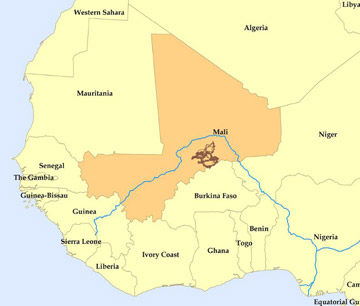 Brown lines show migration routes of Mali’s elephants. Map courtesy of the Mali Elephant Project. |
Given the scale and complexity of the problems, how could the elephants be saved? Canney and her team turned to the people who had the most stake: the local community.
“We began by sharing the results of our studies and asking the locals what they thought about our results and about elephants in general,” she said. “We found that a common attitude was ‘we don’t want the elephants to disappear, because if the elephants disappear, it means the environment is no longer good for us.'”
The local community set up a local management committee, instigated enforcement patrols, and set aside a massive area of land for the elephants. The situation improved, but then in 2012 came a coup, rebellion, and war.
“[We] feared greatly for the elephants’ safety,” noted Canney. “The elders said they would help by transmitting the message far and wide, including to the leaders of the armed groups, that killing elephants stole from the local people. We recruited young volunteers to act as vigilance networks watching out for elephant killings and suspicious activity. Although we only paid them in food, none joined the jihadist groups (who were paying $30-$50 per day) because they said our work was more ‘noble.’ Only eight elephants have been killed since January 2012.”
In a 2014 interview with mongabay.com, Susan Canney explains why Mali’s elephants are so special, the threats they faced, and how a local community kept their great elephant herd alive.
AN INTERVIEW WITH SUSAN CANNEY
Mongabay: What’s your background?
Susan Canney: I am a natural scientist by training, specializing in Zoology, with masters degrees in landscape architecture, environmental policy and a doctorate in conservation ecology. I’ve worked on a variety of projects in science and conservation, mostly in Africa but also Asia, Europe and the U.S,, and as a researcher for the UK government’s independent advisor on sustainable development just after the Rio conference. Because the real world is complex, I’ve been interested in finding ways to rigorously deal with complexity which has taken me into such areas as remote sensing and systems approaches.
Mongabay: What drew you to the elephants of Mali?
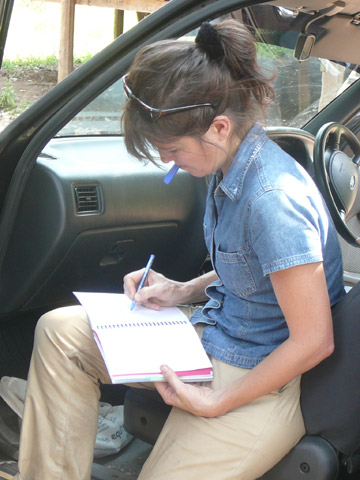 On the job: Canney taking notes in the field. Photo courtesy of Susan Canney. |
Susan Canney: I had just completed my doctorate using satellite imagery and GIS to understand human impact in and around a Tanzanian game reserve, and was put in touch with Iain Douglas-Hamilton of Save the Elephants who had GPS-collared three of the Mali elephants in 2000-2001 but the data still needed to be interpreted to understand why they undertook such a migration, how they had survived, and what conservation intervention was required. It was a fascinating task but in 2006, after three years peering into their migration (see map at end of interview), it was clear that if things didn’t start turning around within about 5 years, they would be on the way to extirpation, and so with The WILD Foundation, I began working with the government and the local people to find a way to secure their future.
Mongabay: What makes Mali’s elephants distinct? Will you tell us about their migration?
Susan Canney: They are the most northerly in Africa, represent 12 percent of west African elephants, and make a huge and unusual annual circular migration. They move quickly or ‘streak’ between places where they spend the majority of their time or ‘concentration areas’. By using satellite imagery and any other data I could lay my hands on, it was possible to use these patterns to understand the migration, and how they had managed to survive when those of comparable latitude had disappeared.
The elephants spend the dry season in the north of the range moving between lakes. These lakes are surrounded by forest and so they find food, water, refuge and shade. As one lake dries, they move to another until the end of the dry season when they all collect around the only lake that never dries, Lake Banzena. When the rains come, they move south where they find better quality food, but can only stay there while it rains as there is little dry season surface water. Their distribution in the south is highly clumped, however. One of these areas was controlled by a powerful local pastoralist chief who had been able to prevent people from clearing land to cultivate, and so this area provided a haven for the elephants. They then dash over a large sand dune that has no water or cover, through an area of large fields and over the border into Burkina Faso, where they find sanctuary in a protected area designated after a border war between the two countries in the 1980s. As the surface water begins to dry they move north stopping at a source of salt before regaining their dry season range.
Mongabay: Will you describe for us the situation that was coming to head between the local population and the elephants?

Mali’s elephants enjoy wading. Photo by: Carlton Ward Jr.
Susan Canney: When we started this work it was clear the area was suffering from resource degradation and over-exploitation. People were clearing bushland to cultivate, only to abandon it after a couple of years leaving the soil to erode. Increasingly large herds of cattle were drinking the lakes dry and trampling the soil. Forests around the lakes were cut for fodder and cleared to make gardens, thus blocking the elephant routes to water. Much of the elephant range burned every year, often because agriculturalists in the south set fires to prevent herders bringing their livestock to graze. The elephants have to pass through some hills to get to their wet season range. In the 1970s the elephants used all the passes through the hills but by 2003 they were using the only pass without a human settlement, however more and more millet fields were appearing each year and a settlement was likely to follow soon. Looking at the elephant range as a whole revealed how changes in one area produced knock-on impacts elsewhere. Incremental change throughout the elephant range meant that the elephants were relying more and more on Lake Banzena, at the same time as human settlement and use of the lake was also increasing, and in 2009 Lake Banzena dried up.
Mongabay: What happened when you began to talk to locals about the issue of elephant conservation?
Susan Canney: We began by sharing the results of our studies and asking the locals what they thought about our results and about elephants in general. We found that a common attitude was “we don’t want the elephants to disappear, because if the elephants disappear, it means the environment is no longer good for us.”
Mongabay: What solutions did the locals come up with in order to protect elephants and improve their own lot?

Interviewing locals about their lives and elephants. Photo courtesy of the Mali Elephant Project.
Susan Canney: Lake Banzena was the top priority for action, and we began by talking to people about their lives, the problems they encountered and their experience of elephants. The local people were happy to move and leave the lake for elephant use if an area was found outside the elephant range with good pasture and clean water, and so worked with them to find an area and raised money to sink the boreholes to provide water. A management committee was elected to establish rules of resource use that included protection of elephant habitat and the migration route, and charging the large prestige herds for access to water and pasture. “Brigades” of young men were formed to patrol and work with government foresters to provide the enforcement. Their first decision was to set aside an area of reserve pasture the size of Yellowstone and protect it with fire-breaks, and this was the only part of the northern elephant range that didn’t lose its pasture to fire that year.
Mongabay: How has Mali’s recent conflict and political crisis impacted people in your conservation area? How about the elephants? How have you been able to prevent the elephant poaching crisis that has occurred in many other places in Africa?
Susan Canney: After the rebellion and coup, the government retreated to the capital and the area became overrun by armed groups, lawless, and awash with guns. Some fled the conflict and for those who stayed the biggest problems were obtaining grain for food (as all supply vehicles were hijacked) and the recruitment by armed groups of their young men. We helped by bringing grain in by donkey cart but feared greatly for the elephants’ safety. The elders said they would help by transmitting the message far and wide, including to the leaders of the armed groups, that killing elephants stole from the local people. We recruited young volunteers to act as vigilance networks watching out for elephant killings and suspicious activity. Although we only paid them in food, none joined the jihadist groups (who were paying $30-$50 per day) because they said our work was more “noble”. Only eight elephants have been killed since January 2012.
Mongabay: What is the current situation like? How do you plan to move forward?

A community forest patrol. Photo courtesy of the Mali Elephant Project.
Susan Canney: There is some remnant insecurity caused by bandits. These are individuals who joined the armed groups but dare not return to their communities for fear of being handed over to the authorities. Local communities have been left socially divided, and many are still in refugee camps. We surveyed a range of individuals from refugees to those who stayed throughout the conflict to ascertain their motivations and intentions. The results indicated that aid and development activities risk exacerbating social wounds and creating environmental problems in the future if they are not carried out in conjunction with local communities and include community reconciliation. We held a three-day workshop that brought together high ranking government with representatives of local people to explore the way forward. Project activities now include reconciliation and use elephant and natural resource protection and restoration as a means to help restore the social fabric.
Mongabay: What can people do to help both the Malians and the elephants?
Susan Canney: Funds are always useful of course, but building the supportive context for conservation is vital: keeping informed to be able to stand up for wildlife and the natural world; spreading the word, raising the profile of the issues, and what can be done. All these things ramp up the pressure for action, and the networked world makes these things increasingly effective…politicians follow voters!
Mongabay: Do you believe community conservation represents the future for conservation success?

Mali is a melting pot of human diversity. Here a Tuareg rides a camel with Lake Banzena in the background. Photo by: Carlton Ward Jr.
Susan Canney: Any conservation problem will require a suite of tools that are appropriate to the context. As human occupation of the planet increases in area and intensity, nature increasingly collides with human populations and working with communities is vital for sustainable solutions. However the way communities are engaged is also vital—community conservation can be done badly!
Mongabay: What advice would you give conservationists, especially those working in politically unstable, developing countries?
Susan Canney: Among other things, use existing assets as this will help embed conservation in the local context. These can be people, laws, organizations, aspects of local culture etc. Identify your allies, support them, link them together, and use coalitions to fight corruption. Don’t assume that first perceptions are correct – gather data. At Lake Banzena we initially assumed that increasing human settlement at the lake was linked to the increasing numbers of cattle using the lake, but it was only when we studied the situation that we discovered over 96 percent of the cattle belonged to predominantly urban, middle-classes living hundreds of kms away, who amassed large herds as a sign of prestige.
Susan Canney has co-authored a recently published book on Conservation for Cambridge University Press, and tells the story of the Mali Elephant Project in a 10 minute Tedx talk called Punch above your weight: the case of the Mali elephants. The Mali Elephant Project is a joint initiative of The WILD Foundation and the International Conservation Fund of Canada, and working with many collaborators.

Mali’s elephant love to wallow. It cools them down, protects them from the sun, and even guards against parasites. Photo by: Carlton Ward Jr.

Detailed map of Canney’s research tracking Mali’s elephant migration. Graph courtesy of Mali Elephant Project. Click to enlarge.

Filling goatskins with water from Lake Banzena. Photo by: Carlton Ward Jr.

Locals collect firewood in the Gandamia hills. Photo by: Carlton Ward Jr.

Elephants in Lake Banzena. Photo by: Carlton Ward Jr.

Funlani herder walking across dunes at the northern edge of the elephants’ range. Photo by: Carlton Ward Jr.
Related articles
(02/12/2014) Forest elephants have suffered unprecedented butchery for their ivory tusks over the past decade, according to new numbers released by conservationists today in London. Sixty-five percent of the world’s forest elephants have been slaughtered by poachers over the last dozen years, with poachers killing an astounding nine percent of the population annually. Lesser-known than their savannah cousins, a genetics study in 2010 found that forest elephants are in fact a distinct species, as far removed from savannah elephants as Asian elephants are from mammoths. These findings make the forest elephant crisis even more urgent.
Hong Kong to destroy 4,000 dead elephants’ worth of ivory

(01/24/2014) The government of Hong Kong will destroy 28 tons of ivory confiscated from traffickers, reports CNN. The announcement, which comes just weeks after China destroyed six tons of seized ivory, suggests that the leaders of the world’s largest market for ivory may be getting more serious about addressing a global poaching boom, say conservationists.
China destroys 6 tons of elephant ivory
(01/06/2014) China authorities destroyed 6.1 tons of illegal ivory during a public event held in Guangzhou on Monday.
Anti-elephant poaching story goes viral in China

(12/20/2013) A newspaper story about the impact of the ivory trade has gone viral in China, raising awareness among millions of Chinese, reports the Wildlife Conservation Society (WCS). The story, published November 15 in Southern Weekly, has been shared widely across Chinese web sites and social media.
Little elephant is the first scientific record of dwarfism in the wild

(12/19/2013) Biologists in Sri Lanka have published the first documented evidence of dwarfism in an adult wild animal. A male Asian elephant (Elephas maximus) measuring just over 1.5 meters (five feet) in height was seen in an aggressive encounter with another male of average size. The elephant’s small stature was due to disproportionately short legs, according to the findings published in the IUCN/SSC Asian Elephant Specialist Group journal Gajah.
“The ‘dwarf’ was by far the main aggressor in the altercation and appeared to be older than the other, a young adult,” states the study. “Other than for the disproportionately short legs, morphologically and behaviorally the dwarf appeared normal.”
Microsoft founder funds Africa-wide elephant survey to measure ivory poachers’ toll
(12/04/2013) Beginning next year, light planes and helicopters will undertake the first ever continent-wide aerial survey of Africa’s vanishing elephant populations. The hugely ambitious initiative, which will count elephant herds in 13 countries, is being funded by Microsoft founder, Paul Allen, through his Paul G. Allen Family Foundation.
22,000 elephants slaughtered for their ivory in 2012
(12/02/2013) As the African Elephant Summit open in Botswana today, conservationists released a new estimate of the number of African elephants lost to the guns of poachers last year: 22,000. Some 15,000 elephants killed in 42 sites across 27 countries on the continent, according to newly released data from the CITES program, Monitoring the Illegal Killing of Elephants (MIKE). But conservationists estimate another 7,000 went unreported. The number killed is a slight decrease over 2011 numbers of 25,000.
Illegal timber, rhino horn, elephant ivory seized in raids across Africa
(12/01/2013) Raids in southern and eastern Africa yielded a stash of contraband linked to illegal poaching and logging, reports Interpol, which coordinated the operations.
Remote sensor captures sound of ivory poacher shooting an elephant
(11/20/2013) A sensor used by researchers to capture low-frequency communication between elephants inadvertently recorded the audio of an elephant being gunned down by a poacher in Gabon, reports the Wildlife Conservation Society, which used the sound byte in a video highlighting the carnage of the ivory trade.









